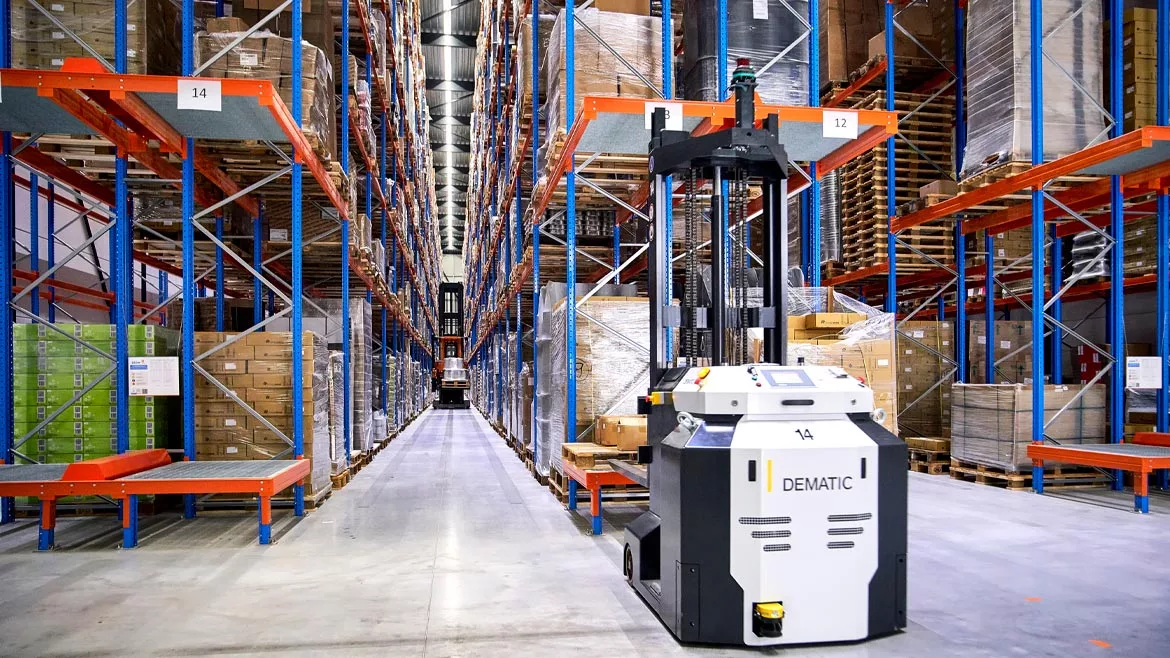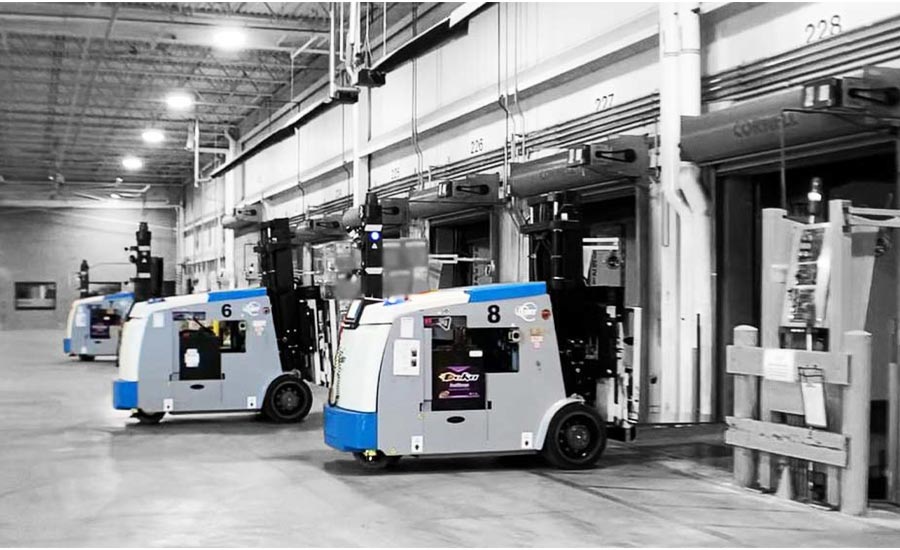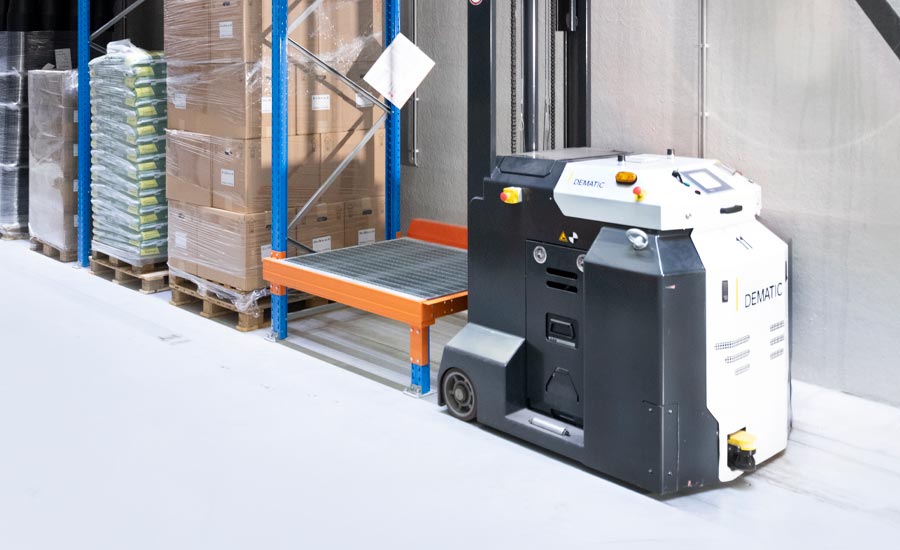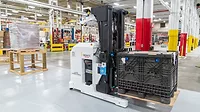Warehouse
Automated guided vehicles help warehouses address labor shortage
AGVs support safety efforts within distribution centers

Experts highlight AGVs as a solutions to address the labor shortage impacting warehouses.
Image courtesy of Dematic
As of June, those working in the transportation and warehousing sector is up 8.1% compared with the same month as last year, based on data from the Bureau of Transportation Statistics from the Bureau of Labor Statistics’ Current Employment Statistics (CES) show. Although this is a positive turn for the sector, experts note the challenges that warehouse operations are facing in terms of staffing still remain.
“Many of the companies I am engaging with right now are feeling a severe impact of the labor shortages. Many are struggling with finding qualified labor,” says Doug Houghton, smart factory development manager of food and beverage for JBT Corp., Chalfont, Pa. “Oftentimes within the [distribution centers] (DCs) and manufacturing, the need is not just finding a ‘warm body’ to operate a forklift but finding operators that are skilled enough to be able to load/unload pallet racking or load/unload trailers without damage to either the infrastructure or the product.
“The turnover rate for some DCs can be above 150% and as high as 400%,” he continues. “When you consider that the DC needs on average 150 FTO (fork truck operator), this is a huge number, making full employment within the DC very difficult.”
Lorne Weeter, vice president of sales of mobile automation Americas for Dematic, Grand Rapids, Mich., also highlights the challenges with the labor force for warehouses.

Image courtesy of JBT Corp.
“As with all industries, warehouse operations are experiencing pressures caused by labor shortages and the cost of labor for those who can find associates. To alleviate this, companies are evaluating all ‘nonvalue added labor’ activities and determining which ones can be automated,” he explains. “This frees up available workers to perform ‘valued added’ tasks. For example, automated guided vehicles (AGVs) can easily transport and store pallets, which allows the forklift drivers to perform other tasks.
“Additionally, increased product demand and increased expectations from consumers for quick delivery continue to put a strain on warehouses and distribution centers across the country,” Weeter continues. “We have all experienced delays in shipments since the pandemic started, and the combination of these factors will continue to inflict stress on the supply chain for the foreseeable future. Given these continued pressures, the industry has embraced its new reality and started to apply automation ― not only for today’s problems, but for tomorrow’s challenges.”
Reports show that this embracement of automation is set to continue. Dublin-based ResearchAndMarkets.com released its “Automated Guided Vehicle - Global Market Trajectory & Analytics” report in June, which estimates the global market for automated guided vehicles (AGV) at $1.9 billion in 2020, and projects it to reach a size of $2.9 billion by 2027. For the United States, the report estimates AGVs’ market size at $393.8 million in 2020.
Tangible benefits
The increasing size for the AGV market, likely lies with its ability to not only address the labor shortages, but also work extended hours.
“Automation is a strong solution to the labor shortages. An AGV/LGV system will work 24/7 and transport, store and load pallets into trailers with little or no manual intervention,” JBT’s Houghton says. “When combining an AGV/LGV solution with other automation (pallet shuttles, ASRS, etc.,) the impact on the employment shortage is enormous. Automation is no longer being considered as a ‘nice to have’ but has rapidly become a ‘must have’ for most of the DCs and eCommerce facilities.”

Image courtesy of Dematic
Dematic’s Weeter notes that those who invested prior to the pandemic in flexible automation were able to more easily adapt to the supply chain constraints that arose. “Flexible automation begins by developing software that monitors data to predict changes in demand, allowing for easier and more efficient operations adjustments,” he says.
Weeter notes that for more than 50 years, AGVs have helped move materials and products, but have become even more valuable to the supply chain.
“AGVs are capable of doing almost anything a forklift can do, such as transporting, lifting and storing. They can also load a semi-trailer with up to four pallets at a time, increasing efficiency and, therefore, profits,” he explains. “While AGVs are certainly a solution to the labor shortage, they are also a key piece of the flexible automation solution. AGVs can easily plug into a warehouse and work alongside conveyors, humans and other robotics. This one solution can offer flexibility while also helping to boost productivity.”
Also highlighting numerous benefits of AGVs, including reduction in product damage, reduction in mis-shipped/misplaced product, JBT’s Houghton explains AGV solutions have streamlined the onboarding steps, allowing warehouses to implement the equipment and benefits that much faster.
“The speed with which AGVs can be installed has become one of the biggest improvements. Some AGVs can be installed in a matter of hours and days,” he says. “Another area that the AGVs have improved is in the navigation. 3-D lidar is becoming the norm and allowing for vehicles to travel at higher speeds and more safely than previously.”
Dematic’s Weeter also notes the advancements that AGVs have realized from technology, including artificial intelligence (AI).
“Modern AGVs use laser- and camera-based navigation, as well as the traditional wire-guided navigation, easily allowing the vehicles to change guide path if needed. This technology has also expanded to include dynamic routing, 3D sensors and more,” he says. “Most recently, advancements in AI have allowed automation providers to simulate how automated vehicles, robots and, most importantly, your employees can work together safely in a space. These tests can bring peace of mind as you introduce new technology, helping to create a balance between safety and efficiency.
“AGVs not only comply with, but actually exceed, the demands of international safety standards,” Weeter continues. “Thankfully, these automated systems are incredibly accurate, providing a safe working environment for both humans and robots without causing collisions or damage to loads.”
Going forward, JBT’s Houghton underscores that safety standards are advancing throughout the AGV sector.
“And finally, speaking of safety, the standards with which the AGVs need to be compliant to are becoming more stringent and there is momentum to bring the industry onto a true industry standard. The ANSI B56 standard has been the benchmark, however, the new ISO standard is being adopted by many of the multinational companies.
It’s safe to say that AGVs are set to be a stronger force in warehouse operations.
Looking for a reprint of this article?
From high-res PDFs to custom plaques, order your copy today!






